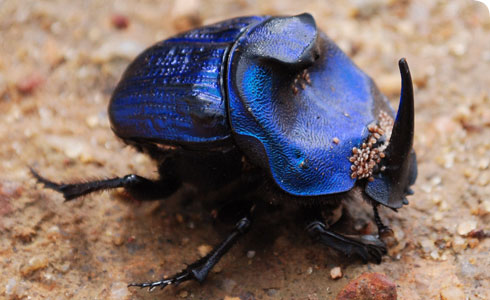Coprophanaeus lancifer (giant Amazonian carrion scarab beetle)
Coprophanaeus lancifer is one of the largest scarab dung beetles in the western hemisphere, reaching a length of up to 5cm.
It is an incredibly bulky and strong insect that is adorned with a striking metallic blue or purple sheen (very rarely green). This beetle is so strong that it is quite impossible to hold a live specimen in your hand.
The species is widespread in the Amazon basin where it prefers to feed on vertebrate carrion rather than dung, which is eaten by most dung beetles.
Both the males and females of this species bear a horn on the head, which they use in territorial fights over burrows with other beetles. The beetles dig their burrows underneath animal carcasses, and this is where the immature stages of the beetle develop.
Other adaptations to this mode of life include:
- very strong legs lined with teeth that help the beetle to dig burrows into the ground, and
- 2 sharp teeth on the clypeus (front of the head), which probably help the beetle to tear at the decomposing carrion and to form brood balls from it
Species detail
-
Taxonomy
The genus Coprophanaeus contains around 40 species distributed from the extreme southern USA to central Argentina, but most species occur in tropical South America. Find out more.
-
Distribution
This scarab beetle prefers lowland rainforest where it searches noisily for animal carcasses at sunset.
-
Biology
These beetles work hard to defend their burrows, which they dig below animal carcasses and use to brood their young. They are immensely strong and can move carcasses the size of an adult human. Discover just how well-adapted they are for digging.
-
Behaviour
Unusually for beetles, both males and females of this species have horns. Find out how they use them and how the sexes can be distinguished.
-
Conservation
This scarab beetle is an indicator species for primary and secondary rainforest, as it is dependant on vertebrates for its survival. Find out more.
-
References
Get reference material for Coprophanaeus lancifer.
Images

Female Coprophanaeus lancifer from the Nouragues reserve, French Guiana.
© Conrad P D T Gillett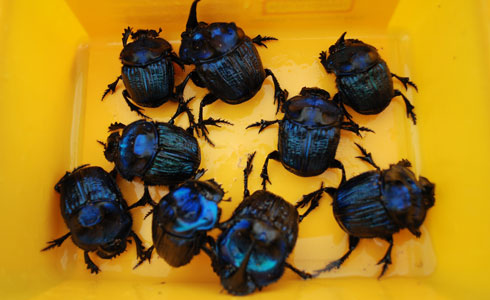
A group of Coprophanaeus lancifer from central Suriname.
© Conrad P D T Gillett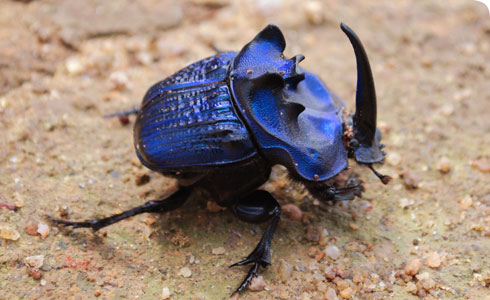
Large male Coprophanaeus lancifer from central Suriname.
© Conrad P D T Gillett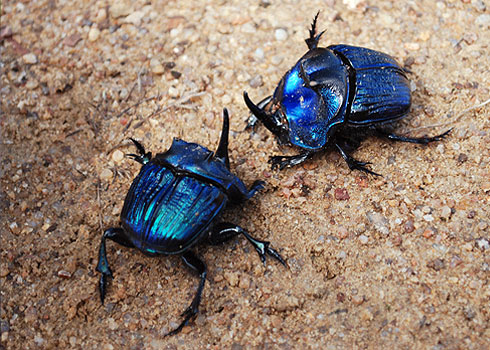
Pair of Coprophanaeus lancifer from central Suriname. The male is on the left.
© Conrad P D T Gillett
2 Coprophanaeus lancifer collected in a pitfall trap, central Suriname.
© Conrad P D T Gillett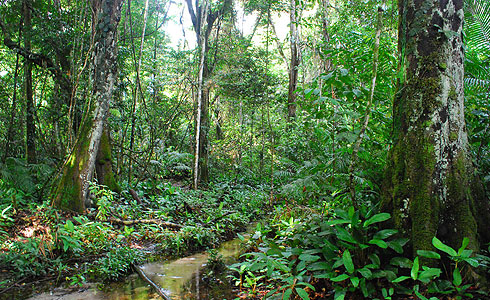
Lowland Amazonian rainforest, the habitat of Coprophanaeus lancifer. Palumeu, central Suriname.
© Conrad P D T Gillett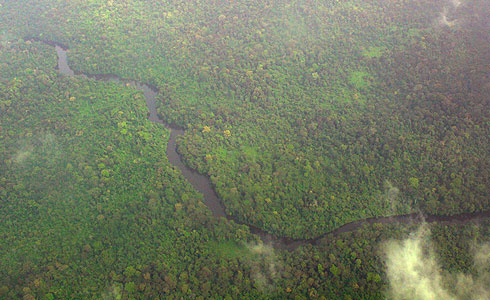
Aerial view of lowland Amazonian rainforest, the habitat of Coprophanaeus lancifer. Southern Suriname.
© Conrad P D T GillettAbout the author
"I will leave a sum in my last will for my body to be carried to Brazil and to these forests. It will be laid out in a manner secure against the possums and the vultures...and this great Coprophanaeus beetle will bury me. They will enter, will bury, will live on my flesh; and in the shape of their children and mine, I will escape death. No worm for me nor sordid fly, I will buzz in the dusk like a huge bumble bee. I will be many, buzz even as a swarm of motorbikes, be borne, body by flying body out into the Brazilian wilderness beneath the stars, lofted under those beautiful and un-fused elytra which we will all hold over our backs. So finally I too will shine like a violet ground beetle under a stone."
– My intended burial and why, W D Hamilton, evolutionary biologist
Read 'My intended burial and why' in Google books